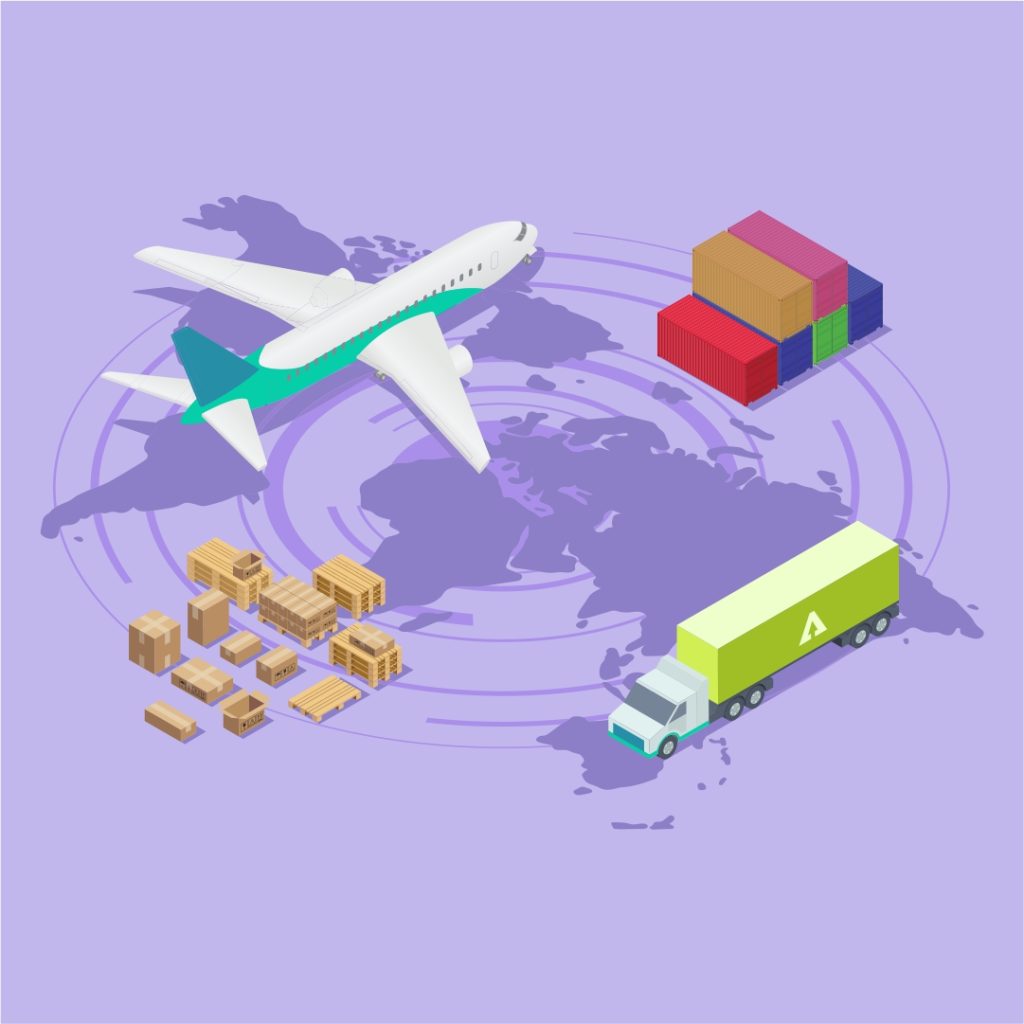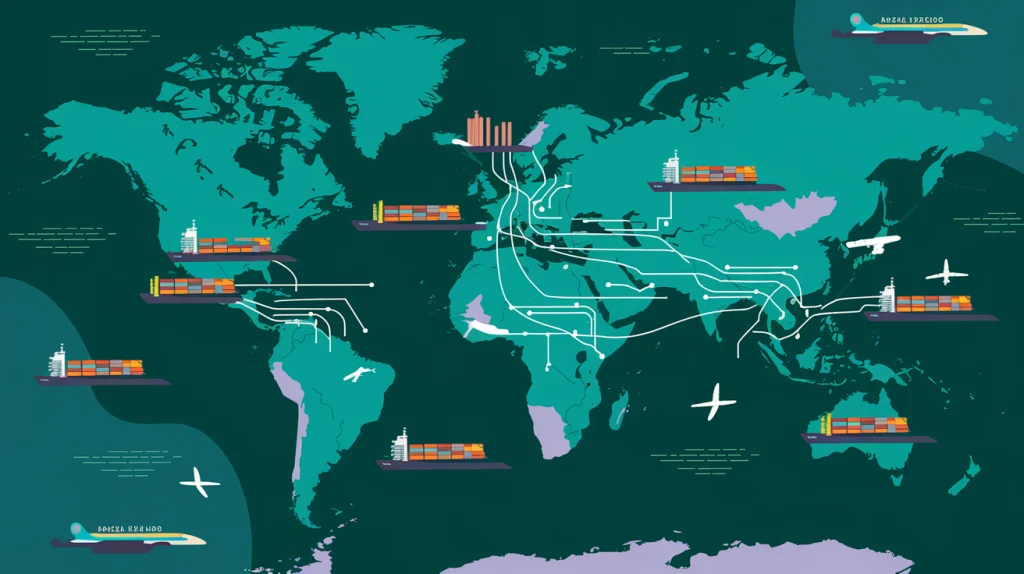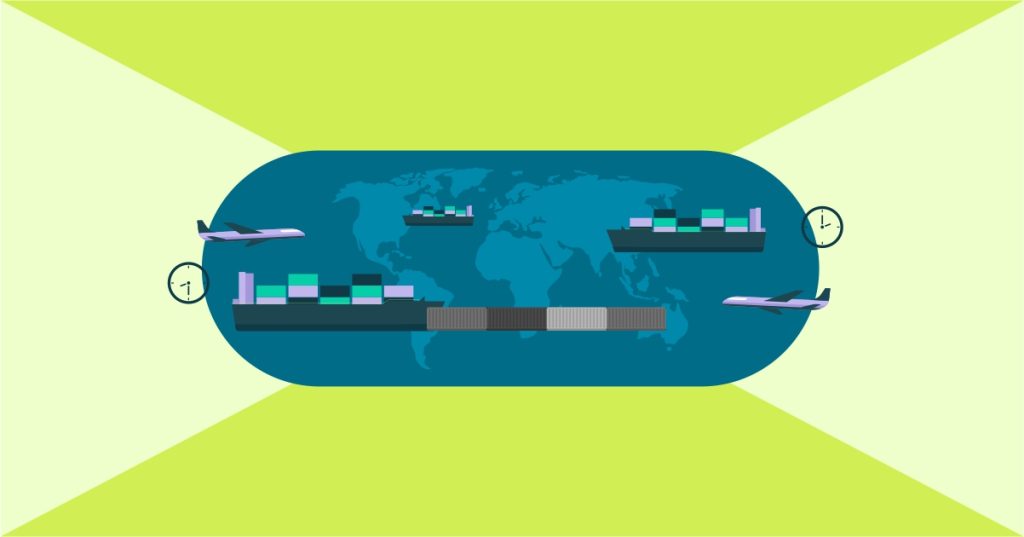The Essential Guide to Air Cargo Shipping
Need to get your products delivered quickly, especially with the holiday rush approaching? Air cargo freight could be the answer. In this guide, we’ll break down air freight, exploring its advantages and disadvantages. We’ll also compare it to sea freight to help you decide which method is best for your needs.
This guide provides the information you need to elevate your shipping strategy, whether you’re focused on supply chain optimization, cost reduction, or staying ahead of market trends. We’ll also look at the exciting innovations shaping the future of air freight.
Understanding Air Cargo Freight
Air cargo freight, or simply air freight, is a cornerstone of rapid international trade. It involves transporting goods commercially via cargo planes, with its own set of logistics and costs. Significantly faster than other shipping methods, air freight allows for quicker response times to customer demands and more efficient inventory management.
It’s also crucial for transporting time-sensitive items and allows businesses to expand into international markets, reaching new customers and establishing wider production networks. Air freight seamlessly connects with land and sea transport, creating comprehensive global logistics solutions. This interconnection improves supply chain efficiency, resulting in quicker deliveries, faster product turnover, and reduced storage requirements.

Advantages of Air Freight
For large retailers and those who utilize fulfillment centers, time and security are paramount. Air cargo delivers on both fronts. Imagine your products swiftly moving across the globe, safe and secure throughout their journey. It’s more than just transportation; it’s a comprehensive solution that enhances your brand’s reputation for reliability and efficiency. Let’s explore the benefits of air freight in detail:
Speed and Efficiency:
Air freight delivers goods within hours or days. For example, a New York florist can receive fresh tulips from the Netherlands quickly, ensuring they arrive in pristine condition. This speed keeps production lines moving by delivering essential parts on time and guarantees the timely arrival of important legal documents.
For sellers working with fulfillment centers and offering products that require rapid delivery, such as electronics or fashion items, faster shipping translates to increased sales opportunities. Air freight enables faster inventory restocking, ensuring customers receive the latest products promptly. This helps businesses capitalize on trends and potentially fit in an extra sales cycle before a season ends.
Pro Tip: While air freight offers significant speed advantages, it’s crucial to balance the cost with the potential benefits. Sometimes, a combination of air and ocean freight is the most effective approach, depending on the product and urgency.
Faster inventory turnover and reduced storage costs, such as rent and utilities, are added benefits. A clothing store, for instance, can order coats closer to winter, minimizing storage duration and offering the latest styles.
E-commerce Agility:
Air freight empowers businesses to respond quickly to market fluctuations and seasonal demands. For instance, they can fly in trendy summer apparel just in time for peak online shopping season.
This agility also helps maintain lean inventory levels, minimizing the risk of obsolescence and spoilage, particularly for perishable goods.
Consider a large apparel importer preparing for the upcoming fashion season. Trends are constantly evolving, and timing is crucial for meeting retailer demand. With air freight, they can swiftly import the latest designs from manufacturing hubs, ensuring they hit warehouses and distribution centers precisely when needed. This speed allows them to fulfill large wholesale orders promptly, keeping retailers stocked and minimizing potential lost sales due to inventory delays.
Similarly, imagine a major office supply importer gearing up for the back-to-school rush. Demand for essential school supplies skyrockets within a short window. Using air freight, they can rapidly import bulk shipments of notebooks, pens, and other supplies from overseas production facilities. This ensures they have ample inventory on hand to meet the surge in wholesale orders from retailers, avoiding stockouts during this critical sales period.
Air freight also facilitates seamless seasonal transitions. As summer approaches, e-commerce sellers can rapidly restock popular summer items, ensuring they’re prepared for increased customer demand.
At Unicargo, we can leverage your past sales data and industry trends to help you anticipate peak demand for your products. This allows you to plan your inventory and secure air cargo space in advance, particularly during high-demand periods, potentially leading to better rates.
We offer expedited shipping to deliver your stock quickly, handle customs processes smoothly, and provide real-time tracking for complete transparency. This support system enables you to effectively plan marketing and promotions while keeping your customers informed about delivery timelines.
Reliability and Security:
Beyond speed, air freight offers significant advantages in reliability and security, making it ideal for valuable or sensitive cargo. The stringent security protocols at airports and limited loading points reduce the risk of theft. This heightened security is particularly beneficial for businesses handling large volumes of expensive items.
Specialized equipment like Unit Load Devices (ULDs) at air cargo facilities ensures the safe movement of goods. ULDs are standardized containers or pallets used to handle goods safely and efficiently by optimizing aircraft space. Trained handlers follow strict procedures for fragile and hazardous materials.
Air freight also offers climate-controlled environments, maintaining product quality for temperature-sensitive items like pharmaceuticals and perishables.
Scheduled air cargo flights operate reliably, minimizing unforeseen delays. Air freight providers often have contingency plans in place for unexpected events like severe weather or mechanical issues, ensuring timely delivery and better business planning. These plans may involve backup flight routes, dedicated teams to manage emergencies, and clear communication channels to keep customers informed and manage expectations.
Global Reach and Connectivity:
Air freight transcends geographical boundaries, connecting businesses to a vast network of markets worldwide. With thousands of airports acting as central hubs, goods can be transported across vast distances, making even remote areas accessible. This extensive airport network is particularly beneficial for businesses focused on aggressive expansion.
By facilitating the movement of resources and goods between developed and developing countries, air freight becomes a powerful driver of economic growth, allowing businesses to source materials, manufacture products, and access new markets on a global scale.
For sellers working with fulfillment centers, air freight minimizes risk when exploring new markets. They can begin by shipping small quantities to gauge customer interest before scaling up. This cautious approach allows sellers, especially those in developing countries, to expand strategically and build a solid international presence.
Air freight also facilitates international trade agreements and participation in free trade zones, reducing trade barriers and creating a level playing field for businesses worldwide.
Integration with multimodal transportation is another advantage. Air cargo often integrates more seamlessly with final delivery compared to ocean freight. While both utilize trucks or trains for the final leg of the journey, air cargo’s speed and direct access to major airports result in quicker customs clearance and faster delivery to customers. This can translate to shorter overall delivery times and lower inventory costs.
Finally, air freight allows businesses to leverage time zone differences for maximum efficiency. For example, a company in New York can send products to Tokyo overnight, ensuring their availability for sale the next morning and minimizing wait times.
Challenges of Air Freight
While air cargo freight offers numerous benefits, it’s essential to consider potential drawbacks before relying solely on this method:
Cost Considerations:
Air freight is often more expensive than other shipping methods due to factors like weight and dimensional weight (size). Airlines charge based on whichever is greater, meaning bulky yet lightweight items can result in higher costs.
While speed is a significant advantage, it’s crucial to determine if the urgency justifies the additional expense.
It’s also important to note that air freight costs extend beyond the base rate. Additional expenses, such as fuel surcharges, security fees, terminal handling charges, and customs clearance, can accumulate quickly. All factors should be taken into account and calculated in the total freight charge when quoted.
Cargo Size and Weight Restrictions:
The size of a shipment is primarily limited by the aircraft’s cargo hold. While standard cargo pallets are approximately 8 feet by 10.3 feet, this can vary depending on the aircraft type. These limitations can pose challenges for large-scale sellers who frequently transport large pallet sizes.
At Unicargo, we can help you determine the most economical and efficient shipping method according to your goods’ packing method. It takes a specialist with a substantial amount of experience to see all angles and recommend the best and most cost-efficient solution for your air freight needs. For items that fit within an aircraft but require special handling, we’ll plan the most efficient route and manage permits and airport logistics.
We’ll also ensure your cargo is properly secured and complies with weight restrictions. If your cargo can be divided into smaller units, we can combine air and ocean freight to balance speed and cost. Our experts manage all logistics, from planning to communication, ensuring a smooth and transparent shipping process.
Each airline establishes specific limits on gross weight, which includes the total weight of the shipment, including packaging. To determine an aircraft’s cargo capacity, you need to consider both the aircraft’s maximum weight limit and any restrictions specific to the trip. A well seasoned expert would know what to do, compared to a normal person trying to make a decision based on gut feeling and what seems logical at times, but may not be the right decision.
Airlines also consider the amount of space cargo occupies, calculated by multiplying the package’s length, width, and height and applying a conversion factor. The greater of the gross weight or volumetric weight determines the final shipping cost.
For example, an Amazon FBA seller importing large but lightweight plush toys in bulk from China via air freight might encounter higher than expected shipping costs. While the toys are light, their bulkiness results in a higher volumetric weight than their actual weight.
Proper packaging is crucial. Airlines favor dense cargo (heavy for its size) as it maximizes space utilization. Inefficient packaging can increase volumetric weight and drive up costs.
At Unicargo, we can help you optimize your packaging. We can use custom, lightweight packaging or select the right box sizes to minimize wasted space and shifting. We can also consolidate smaller shipments from various clients into a single, larger shipment to reduce volumetric weight charges. Additionally, our massive quantity of space purchased, from the airlines, guarantees a highly competitive price at all times of the year.
Environmental Impact:
While air freight offers unparalleled speed, it’s important to acknowledge its environmental impact. Airplanes consume significant amounts of fuel, releasing greenhouse gases like carbon dioxide (CO2), which contribute to climate change.
In fact, air freight has a larger carbon footprint for large items compared to ocean freight. As the air cargo industry continues to grow, so do emissions, which has led to concerns about its long-term sustainability.
Air Freight vs. Sea Freight: Choosing the Right Option
Deciding between air and sea freight involves weighing several factors. To make an informed choice, let’s compare these two shipping methods across key considerations:
Speed and Delivery Timeframes:
- Air freight: The fastest option, with shipments arriving in a matter of days. This makes air freight ideal for time-sensitive deliveries.
- Sea freight: Significantly slower, with deliveries typically taking several weeks or even months. Sea freight isn’t suitable for products that need to arrive quickly or have short shelf lives, such as perishable goods.
Cost Calculations:
Air freight: Costs are determined by weight (either actual or volumetric weight), distance, and additional fees (customs, fuel surcharges, etc.). Understanding volumetric weight is essential, especially for larger, lighter packages:
- Volumetric Weight: This is a pricing technique used by airlines to account for the space a package occupies in relation to its actual weight. It is calculated using the following formula: (Length x Width x Height) / Dimensional Weight Divisor
- Dimensional Weight Divisor: The divisor varies between carriers. For regular air freight, a common divisor is 6,000 cubic centimeters per kilogram (equivalent to 166.67 kg per cubic meter). Courier services often use a divisor of 5,000 cubic centimeters per kilogram (200 kg per cubic meter).
Example: Imagine a package with dimensions of 100 cm x 50 cm x 50 cm. This gives a volume of 0.25 cubic meters (250,000 cubic centimeters).
- Regular Air Freight: 0.25 CBM x 166.67 kg/CBM = 41.67 kg volumetric weight
- Courier Service: 0.25 CBM x 200 kg/CBM = 50 kg volumetric weight
The Bottom Line: Airlines will charge based on the greater of the actual weight or the volumetric weight. For lightweight but bulky items, volumetric weight can significantly impact costs.
Sea freight: Costs are primarily based on volume (measured in cubic meters or CBMs), but keep in mind:
- Minimum Charges: Sea freight often has minimum charges per shipment, even if the actual cargo doesn’t fill a full container. This minimum is often set at 0.5 CBM. So, even a smaller package might incur the cost of this minimum volume.
Choosing the Right Fit:
Air Freight is Best for:
Products with a limited shelf life: High-demand seasonal items (like holiday decorations), trendy fashion pieces, or products with upcoming launch dates.
High-value electronics and consumer goods: Smartphones, laptops, small drones, designer accessories – anything where speed reduces the risk of theft or damage.
Inventory replenishment for fast-moving products: Quickly restock popular items experiencing high demand or to meet unexpected sales surges (especially important for FBA sellers).
Sea Freight is Ideal for:
Large-volume goods: Bulk orders of everyday household items, furniture, textiles, or items with longer shelf lives.
Heavy machinery and equipment: Manufacturing equipment, construction materials, or large vehicles where air freight would be cost-prohibitive.
Products with predictable demand: Items with consistent sales patterns where longer lead times are acceptable, allowing for cost savings with sea freight.
Here’s a table summarizing the key differences:
| Aspect | Air Freight | Sea Freight |
| Speed | Fastest, delivery in hours or days | Slower, usually takes weeks or months |
| Best For | Perishable items, high-value goods, urgent shipments | Large volumes, heavy cargo, cost-sensitive shipments |
| Cost Factors | Weight (actual or volumetric) and distance | Volume (cubic meters/CBMs) |
| Cost Comparison | Less expensive for small, dense packages | Can be more cost-effective for large, heavy cargo |
| Handling | Limited loading points | Often involves handling at multiple points |
| Environmental Impact | Higher carbon footprint | Lower carbon footprint compared to air freight |
| Packaging Needs | Dense packages preferred to minimize costs | Less critical but still important for space efficiency |
Air Freight and the Holiday Rush
The holiday season presents unique challenges for importers and e-commerce sellers. Shelves empty quickly, online orders surge, and customer satisfaction is paramount. Air freight helps ensure stores remain stocked and gifts arrive on time.
Air freight allows for smarter inventory management. Instead of relying on ocean freight, which can take weeks for restocking, air cargo freight bridges the gap, swiftly moving goods from production centers to retailers, keeping shelves stocked and customers happy.
Additionally, businesses can maintain leaner inventory levels year-round and utilize air freight for quick restocks during demand spikes.
Air freight streamlines peak season logistics. Faster delivery means retailers can respond rapidly to changing trends and restock popular items efficiently.
Pro Tip: To maximize the benefits of air freight, businesses need accurate demand forecasting. This allows them to predict inventory needs and secure air cargo space in advance, avoiding potential delays during the busy holiday season.
Timely deliveries are crucial during the holidays. Air freight ensures gifts arrive on time, reducing the likelihood of stockouts, disappointed customers, and missed gifting opportunities.
With its reliability and speed, air freight is a dependable choice for meeting holiday deadlines, guaranteeing faster delivery than ocean freight. Airlines often increase cargo flights during this time to accommodate the surge in demand, ensuring a steady flow of goods.
Choosing the Right Air Freight Partner
While ocean freight might suffice for bulkier items during most of the year, air freight becomes essential during peak seasons. Selecting the right air freight service partner is critical for ensuring smooth operations and timely deliveries.
Here are some key factors to consider when choosing an air freight partner, particularly for managing the holiday rush:
- Reliability and Reputation: Choose a provider with a proven track record of on-time deliveries and secure cargo handling. Research their industry reputation, checking for awards, positive reviews, and testimonials.
- Experience: Opt for a provider with extensive experience in your industry. Their familiarity with your type of goods ensures smoother handling and fewer regulatory issues.
- Comprehensive Services: A quality provider offers more than just shipping. Look for additional services like customs clearance assistance, packaging and labeling support, cargo insurance, tracking, and door-to-door delivery. Ideally, a vendor who services several legs of the journey can give you an edge, since all is handled in one place and internal communications are quick and more effective. Unicargo offers Air/Sea Freight, Global Warehousing, and domestic Trucking to the final destination (in the U.S.). You talk to one team and one account manager for the entire shipment journey, as opposed to three (if not more) different vendors who lack communication between them.
- Global Network: Ensure your chosen provider has a robust international network, including strong airline and agent partnerships. This ensures seamless cargo movement across borders.
- Technology: Modern providers utilize technology for faster processing and real-time tracking. Look for online booking, shipment updates, and electronic data interchange (EDI) capabilities.
- Customer Feedback: Online reviews and industry publications can offer valuable insights into air freight service providers. Check reviews on trusted sites and seek feedback from other businesses to assess performance and customer service quality.
- Specialized Services: Determine if the provider can handle your specific cargo needs, whether it’s perishable items, oversized freight, or hazardous materials. Ensure they offer the necessary services for a successful shipment.
Unicargo: Elevating Your Business with Comprehensive Air Freight Solutions
At Unicargo, we understand that businesses require reliable, cost-effective air freight services. Whether you’re shipping a small package or multiple pallets, requiring delivery within a day or a week, we can handle it all.
Our air freight services offer:
- Reliable and Affordable Shipping: You can trust that your large shipments will be delivered on time and at competitive rates.
- Proactive Problem Solving: Our extensive experience and strategic planning allow us to anticipate and resolve potential issues before they arise.
- Guaranteed Space and Competitive Rates: Our presence in Asian manufacturing countries and Block Space Agreements (BSAs) with key airlines enable us to offer competitive rates and guaranteed flight space, ensuring reliable service even during peak seasons.
- Comprehensive Solutions: We offer a wide range of value-added services, including labeling, packaging, customs support, insurance, domestic freight brokerage, and warehousing. Our platform provides 24/7 access to status updates, documentation, and seamless tracking.
- Efficient Consolidation: We provide consolidation services, combining multiple small shipments into one larger shipment to reduce costs and maximize efficiency. Our global network of partners and agents enables us to consolidate your goods anywhere in the world, simplifying international shipping.
The Future of Air Freight
The future of air freight is bright, driven by emerging technologies, a commitment to sustainability, and market expansion. Here’s a glimpse into the exciting developments shaping the industry:
- Technological Advancements:
- Autonomous Vehicles: Unmanned aerial vehicles (UAVs), or drones, are poised to revolutionize goods transportation within the air cargo industry. These vehicles utilize GPS, AI, and sensors to navigate and assist with loading and unloading near aircraft.
- Advanced Booking Systems: Real-time data on routes, schedules, and capacity will further enhance booking systems. Many shipping companies have already implemented instant pricing tools that automate air freight pricing across various trade lanes.
- Sustainability:
- Green Technologies: The air freight industry is actively exploring and adopting eco-friendly practices, including electric and hybrid aircraft, sustainable fuels, and optimized route planning to minimize environmental impact.
- Carbon Offsetting: Airlines are increasingly investing in carbon offset programs to counterbalance their emissions, recognizing that sustainable practices are becoming a competitive advantage.
- Market Growth:
- The global air cargo market is projected to experience substantial growth in the coming years, driven by increasing demand for faster shipping and globalization.
Conclusion
Air cargo shipping offers significant opportunities for businesses of all sizes. Its speed, reliability, security, and global reach make it an ideal solution for transporting a wide range of goods, from essential medical supplies to the latest fashion trends.
While cost and environmental impact are factors to consider, air freight can provide a distinct competitive advantage, especially during peak seasons and for time-sensitive shipments. Choosing the right air freight service partner is crucial for maximizing efficiency and minimizing risk.
Unicargo’s robust global air cargo freight network, commitment to innovation, and customer-centric approach make us an ideal partner. We offer competitive rates, guaranteed space, and a comprehensive suite of services to streamline your shipping operations. Contact us today to discover how our air freight solutions can help your business efficiency and growth.


